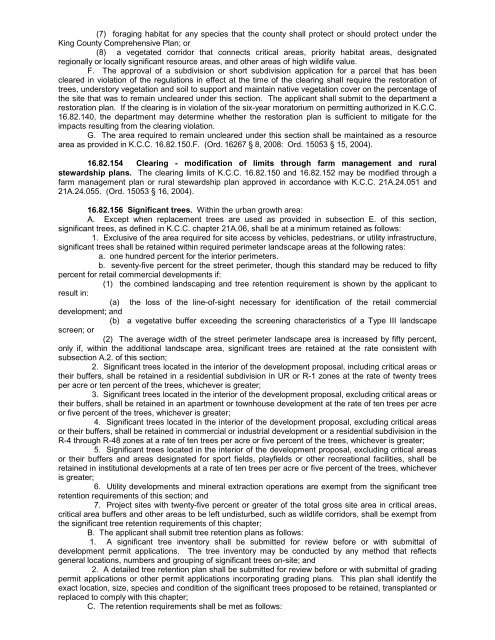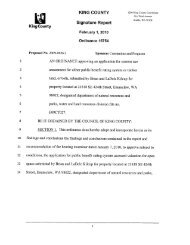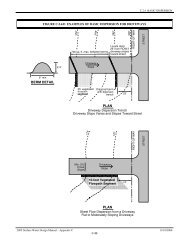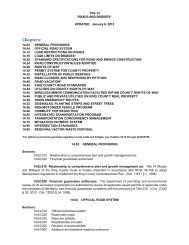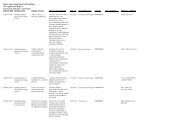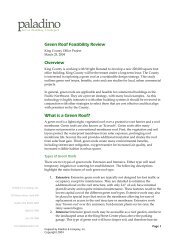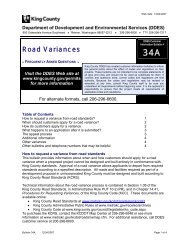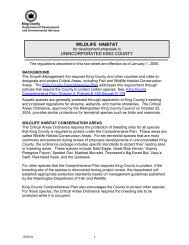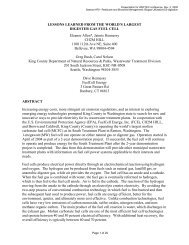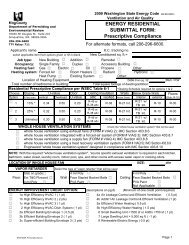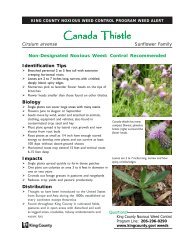Title 16 - BUILDING AND CONSTRUCTION ... - King County
Title 16 - BUILDING AND CONSTRUCTION ... - King County
Title 16 - BUILDING AND CONSTRUCTION ... - King County
You also want an ePaper? Increase the reach of your titles
YUMPU automatically turns print PDFs into web optimized ePapers that Google loves.
(7) foraging habitat for any species that the county shall protect or should protect under the<br />
<strong>King</strong> <strong>County</strong> Comprehensive Plan; or<br />
(8) a vegetated corridor that connects critical areas, priority habitat areas, designated<br />
regionally or locally significant resource areas, and other areas of high wildlife value.<br />
F. The approval of a subdivision or short subdivision application for a parcel that has been<br />
cleared in violation of the regulations in effect at the time of the clearing shall require the restoration of<br />
trees, understory vegetation and soil to support and maintain native vegetation cover on the percentage of<br />
the site that was to remain uncleared under this section. The applicant shall submit to the department a<br />
restoration plan. If the clearing is in violation of the six-year moratorium on permitting authorized in K.C.C.<br />
<strong>16</strong>.82.140, the department may determine whether the restoration plan is sufficient to mitigate for the<br />
impacts resulting from the clearing violation.<br />
G. The area required to remain uncleared under this section shall be maintained as a resource<br />
area as provided in K.C.C. <strong>16</strong>.82.150.F. (Ord. <strong>16</strong>267 § 8, 2008: Ord. 15053 § 15, 2004).<br />
<strong>16</strong>.82.154 Clearing - modification of limits through farm management and rural<br />
stewardship plans. The clearing limits of K.C.C. <strong>16</strong>.82.150 and <strong>16</strong>.82.152 may be modified through a<br />
farm management plan or rural stewardship plan approved in accordance with K.C.C. 21A.24.051 and<br />
21A.24.055. (Ord. 15053 § <strong>16</strong>, 2004).<br />
<strong>16</strong>.82.156 Significant trees. Within the urban growth area:<br />
A. Except when replacement trees are used as provided in subsection E. of this section,<br />
significant trees, as defined in K.C.C. chapter 21A.06, shall be at a minimum retained as follows:<br />
1. Exclusive of the area required for site access by vehicles, pedestrians, or utility infrastructure,<br />
significant trees shall be retained within required perimeter landscape areas at the following rates:<br />
a. one hundred percent for the interior perimeters.<br />
b. seventy-five percent for the street perimeter, though this standard may be reduced to fifty<br />
percent for retail commercial developments if:<br />
(1) the combined landscaping and tree retention requirement is shown by the applicant to<br />
result in:<br />
(a) the loss of the line-of-sight necessary for identification of the retail commercial<br />
development; and<br />
(b) a vegetative buffer exceeding the screening characteristics of a Type III landscape<br />
screen; or<br />
(2) The average width of the street perimeter landscape area is increased by fifty percent,<br />
only if, within the additional landscape area, significant trees are retained at the rate consistent with<br />
subsection A.2. of this section;<br />
2. Significant trees located in the interior of the development proposal, including critical areas or<br />
their buffers, shall be retained in a residential subdivision in UR or R-1 zones at the rate of twenty trees<br />
per acre or ten percent of the trees, whichever is greater;<br />
3. Significant trees located in the interior of the development proposal, excluding critical areas or<br />
their buffers, shall be retained in an apartment or townhouse development at the rate of ten trees per acre<br />
or five percent of the trees, whichever is greater;<br />
4. Significant trees located in the interior of the development proposal, excluding critical areas<br />
or their buffers, shall be retained in commercial or industrial development or a residential subdivision in the<br />
R-4 through R-48 zones at a rate of ten trees per acre or five percent of the trees, whichever is greater;<br />
5. Significant trees located in the interior of the development proposal, excluding critical areas<br />
or their buffers and areas designated for sport fields, playfields or other recreational facilities, shall be<br />
retained in institutional developments at a rate of ten trees per acre or five percent of the trees, whichever<br />
is greater;<br />
6. Utility developments and mineral extraction operations are exempt from the significant tree<br />
retention requirements of this section; and<br />
7. Project sites with twenty-five percent or greater of the total gross site area in critical areas,<br />
critical area buffers and other areas to be left undisturbed, such as wildlife corridors, shall be exempt from<br />
the significant tree retention requirements of this chapter;<br />
B. The applicant shall submit tree retention plans as follows:<br />
1. A significant tree inventory shall be submitted for review before or with submittal of<br />
development permit applications. The tree inventory may be conducted by any method that reflects<br />
general locations, numbers and grouping of significant trees on-site; and<br />
2. A detailed tree retention plan shall be submitted for review before or with submittal of grading<br />
permit applications or other permit applications incorporating grading plans. This plan shall identify the<br />
exact location, size, species and condition of the significant trees proposed to be retained, transplanted or<br />
replaced to comply with this chapter;<br />
C. The retention requirements shall be met as follows:


